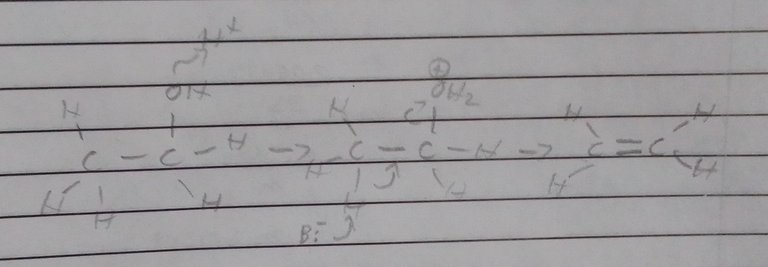Síntesis de alquenos/ Synthesis of alkenes
Versión en español
Los alquenos son hidrocarburos insaturados que tienen doble enlace carbono-carbono en su molécula de fórmula general CnH2n. Los alquenos se encuentran entre los compuestos industrial más importantes y también se pueden encontrar en plantas y animales. Entre las diversas formas de sintetizar a los alquenos las más conocidas y utilizadas son la deshidrohalogenacion y la deshidratación, que de ellas hablaremos en este post.
Deshidrohalogenacion
La deshidrohalogenación es la eliminación de un hidrógeno y un halógeno de un haluro de
alquilo para formar un alqueno. De las dos eliminaciones estudiadas (E1 y E2), por lo general la reacción de segundo orden es mejor para efectos de síntesis, ya que la de primer orden tiene más reacciones competidoras. La deshidrohalogenación E2 ocurre en un paso, en el cual una base fuerte abstrae un protón de un átomo de carbono mientras el grupo saliente abandona el carbono adyacente.

Se omiten los productos colaterales
En este tipo de reacciones las bases y sustratos con gran impedimento estérico favorecen las reacciones E2, porque mientras más impedidos estén menos probable es que ocurra una reacción de sustitución. Esta reacción es estereoespecifica.
Deshidratación de alcoholes
La deshidratación de alcoholes es un método común para preparar alquenos. La palabra deshidratación significa literalmente “eliminación de agua”.

Se omiten los productos colaterales
Con frecuencia se utiliza ácido sulfúrico y ácido fosfórico concentrados como reactivos para la deshidratación, ya que estos ácidos actúan tanto como catalizadores ácidos como agentes deshidratantes. El mecanismo de la deshidratación se parece al mecanismo E1. El grupo hidroxilo del alcohol es un mal grupo saliente (OH), pero la protonación mediante el catalizador ácido lo convierte en un buen grupo saliente (H2O). En el segundo paso, la pérdida de agua a partir del alcohol protonado genera un carbocatión. Éste es un ácido muy fuerte: cualquier base débil como el H2O o HSO4 puede abstraer el protón en el último paso para generar el alqueno. Como otras reacciones E1, la deshidratación de alcoholes sigue un orden de reactividad que refleja la estabilidad del carbocatión: los alcoholes 3° reaccionan de una manera más rápida que los alcoholes 2°, y los 1° son los menos reactivos.
English version
Alkenes are unsaturated hydrocarbons that have carbon-carbon double bonds in their molecule of general formula CnH2n. Alkenes are among the most important industrial compounds and can also be found in plants and animals. Among the various ways to synthesize alkenes, the best known and most commonly used are dehydrohalogenation and dehydration, which we will discuss in this post.
Dehydrohalogenation
Dehydrohalogenation is the elimination of a hydrogen and a halogen from an alkyl halide to form an alkene. Of the two eliminations studied (E1 and E2), generally the second order reaction is better for synthesis purposes, as the first order reaction has more competing reactions. E2 dehydrohalogenation occurs in one step, in which a strong base abstracts a proton from a carbon atom while the leaving group leaves the adjacent carbon.

Collateral products are omitted
In this type of reaction, bases and substrates with high steric hindrance favor E2 reactions, because the more hindered they are, the less likely it is that a substitution reaction will occur. This reaction is stereospecific.
Dehydration of alcohols
Dehydration of alcohols is a common method for preparing alkenes. The word dehydration literally means "removal of water".

Collateral products are omitted
Concentrated sulfuric acid and phosphoric acid are often used as reagents for dehydration, as these acids act as both acid catalysts and dehydrating agents. The mechanism of dehydration resembles the E1 mechanism. The hydroxyl group of the alcohol is a bad leaving group (OH), but protonation by the acid catalyst converts it to a good leaving group (H2O). In the second step, the loss of water from the protonated alcohol generates a carbocation. This is a very strong acid: any weak base such as H2O or HSO4 can abstract the proton in the last step to generate the alkene. Like other E1 reactions, the dehydration of alcohols follows an order of reactivity that reflects the stability of the carbocation: the 3° alcohols react faster than the 2° alcohols, and the 1° alcohols are the least reactive.
- Translate by DeepL
Congratulations @ernesto-blguer! You have completed the following achievement on the Hive blockchain And have been rewarded with New badge(s)
Your next target is to reach 200 upvotes.
You can view your badges on your board and compare yourself to others in the Ranking
If you no longer want to receive notifications, reply to this comment with the word
STOPCheck out our last posts:
Keep up the good work. 👏
Recognized by Mystic artist Gudasol
You are loved.
Interested to to help music map cXc.world spread more good vibes on Hive?.